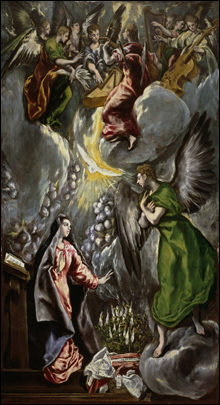
ANNUNCIATION: El Greco is heterodox,
apocalyptic, and centuries ahead of his time.
|
Men in black are coming to Boston. Men in black garb. Men in inky darkness. Men without women (save for the Blessed Virgin). Men in splendor, men in ecstasy, men without smiles. Men as saints but not as sinners. Men in the palace but not in the plaza. Welcome “El Greco to Velázquez: Art During the Reign of Philip III,” a blockbuster created by the Museum of Fine Arts in Boston and the Nasher Museum of Art at Duke University and dedicated to the idea that Spanish king Philip III, who ruled from 1598 to 1621, was not the wimpy failure (a “devout, phlegmatic nonentity,” in the words of the Encyclopædia Britannica) that history would have him. Bookended by Domeniko Theotokopoulos (“El Greco,” though he was born in Crete), who died in Toledo in 1614, and Diego Rodríguez de Silva y Velázquez, who was born in Seville in 1599, the show brings to light Juan Pantoja de la Cruz, Luis Tristán, Vicente Carducho, and other “minor” artists who flourished during Philip III’s reign, and if there are no El Grecos or Velázquezes hiding among them, this is still a blast of Iberian thunder and lightning spread across a huge canvas (the sheer size of some pieces is eye-popping), and a primer of Spanish life and culture in the age of Cervantes and Shakespeare, as revealing in what it omits as in what it includes.
Philip III was the grandson of Holy Roman Emperor Charles V and the youngest son of Philip II, the Spanish ruler who married Queen Mary of England in 1554 and pondered marriage to Queen Elizabeth (after Mary’s death) before sending the Armada to invade England in 1588. Spain under Philip II was a global power, intent on suppressing Protestantism (and enforcing Catholic orthodoxy) in the Old World and enriching its coffers in the New, but the wars with England, France, and the Netherlands drained the treasury; Philip went bankrupt four times in his reign.
Slideshow: “El Greco to Velázquez: Art During the Reign of Philip III”
“El Greco to Velázquez: Art During the Reign of Philip III” Museum of Fine Arts, Boston: April 20–July 27
Period reading
Miguel De Cervantes Saavedra: Don Quixote (Harper)
Lope De Vega: Three Major Plays(Oxford University Press)
Period listening
Jordi Savall + Hespèrion XXI + La Capella Reial de Catalunya: Miguel de Cervantes: Don Quixote: Romances y Músicas (Alia Vox)
|
Philip III was less aggressive, perhaps out of policy, perhaps out of necessity, since revenues from the New World fell 50 percent during his reign. The Treaty of London was signed in 1604–1605 and the Twelve Years’ Truce with the Netherlands began in 1609; that same year, however, the Moriscos — Moors who had converted (in some cases nominally) to Christianity — were expelled from Spain. Philip’s favorite the Duke of Lerma became the first real prime minister in Europe, and he was a patron of the arts, but his administration’s lavish spending culminated in his removal from office on charges of corruption in 1618. That same year, the Thirty Years’ War began. Spain would never again be the global force it had been under Philip II.
Philip III’s Spain is often described as transitional — in artistic terms between the El Greco of Philip II and the Velázquez of Philip IV. Philip II was not, however, an admirer of the heterodox El Greco; it was the Duke of Lerma with whom he found favor in the last decade of his life. And it was the first two decades of the 17th century that nourished Velázquez, as well as Golden Age dramatist Pedro Calderón de la Barca. Philip III’s Spain could also be described as emerging — from the heavy hand of the Counter-Reformation and the Inquisition, and from the heavy hand of Philip II’s foreign policy. Philip III’s Spain was more open to the mystic legacy of Teresa of Ávila and San Juan de la Cruz; its artists had before them the naturalism of Peter Paul Rubens and the tenebrism of Caravaggio, who between 1600 and 1606 was the rage of Rome. Spain’s greatest Renaissance composer, Tomás Luis de la Victoria, ended his career in the reign of Philip III. Miguel de Cervantes Saavedra published the first part of his picaresque romantic satire Don Quixote in 1605 and the second in 1615. The great Spanish Golden Age dramatist Lope de Vega flourished in this period; so did the poet Luis de Góngora y Argote.
At the MFA, “El Greco to Velázquez” showcases 63 paintings and sculptures, beginning with an El Greco room and moving on to “Portraits,” “Religious Subjects” (the Blessed Virgin Mary, with a section devoted to the Immaculate Conception; the life of Christ; apostles and saints), and “Still Lifes.” The lighting is subdued; the walls are painted slate blue and parchment and oyster, and when you leave the saints for the still lifes of the final room, it’s as if you’d survived San Juan de la Cruz’s “dark night of the soul.” Tenebrism — a heightened form of chiaroscuro — holds sway here, humans emerging out of darkness, illuminated by heavenly light. Women, ordinary people, and conventional landscapes are conspicuous by their absence; musical instruments are played only by angels. The world of Don Quixote might as well be on another planet.